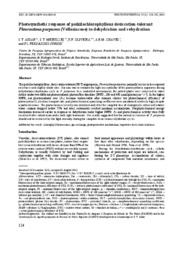Photosynthetic response of poikilochlorophyllous desiccation-tolerant Pleurostima purpurea (Velloziaceae) to dehydration and rehydration.
Photosynthetic response of poikilochlorophyllous desiccation-tolerant Pleurostima purpurea (Velloziaceae) to dehydration and rehydration.
Author(s): AIDAR, S. de T.; MEIRELLES, S. T.; OLIVEIRA, R. F.; CHAVES, A. R. de M.; FERNANDES JUNIOR, P. I.
Summary: The poikilochorophyllous, desiccation-tolerant (PDT) angiosperm, Pleurostima purpurea, normally occurs in less exposed rock faces and slightly shady sites. Our aim was to evaluate the light susceptibility of the photosynthetic apparatus during dehydration-rehydration cycle in P. purpurea. In a controlled environment, the potted plants were subjected to water deficit under two different photosynthetic photon flux densities [PPFD, 100 and 400 μmol(photon) m?2 s?1]. In the higher PPFD, net photosynthetic rate (PN) become undetectable after stomata closure but photochemical efficiency of photosystem II, electron transport rate, and photochemical quenching coefficient were maintained relatively high, despite a partial decrease. The photochemical activity was inhibited only after the complete loss of chlorophylls, when leaf relative water content dropped below 72% and total carotenoids reached maximal accumulation. Nonphotochemical energy dissipation increased earlier in response to dehydration under higher PPFD. PN and photochemical activity were fully recovered after rehydration under both light treatments. Our results suggested that the natural occurrence of P. purpurea should not be restricted by the light intensity during the complete desiccation-rehydration cycles. Additional key words: chlorophyll fluorescence; gas exchange; photoprotective mechanisms; vegetative desiccation tolerance
Publication year: 2014
Types of publication: Journal article
Unit: Embrapa Semi-arid Region
Observation
Some of Embrapa's publications are published as ePub files. To read them, use or download one of the following free software options to your computer or mobile device. Android: Google Play Books; IOS: iBooks; Windows and Linux: Calibre.
Access other publications
Access the Agricultural Research Database (BDPA) to consult Embrapa's full library collection and records.
Visit Embrapa Bookstore to purchase books and other publications sold by Embrapa.

